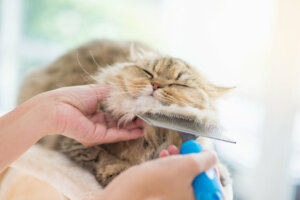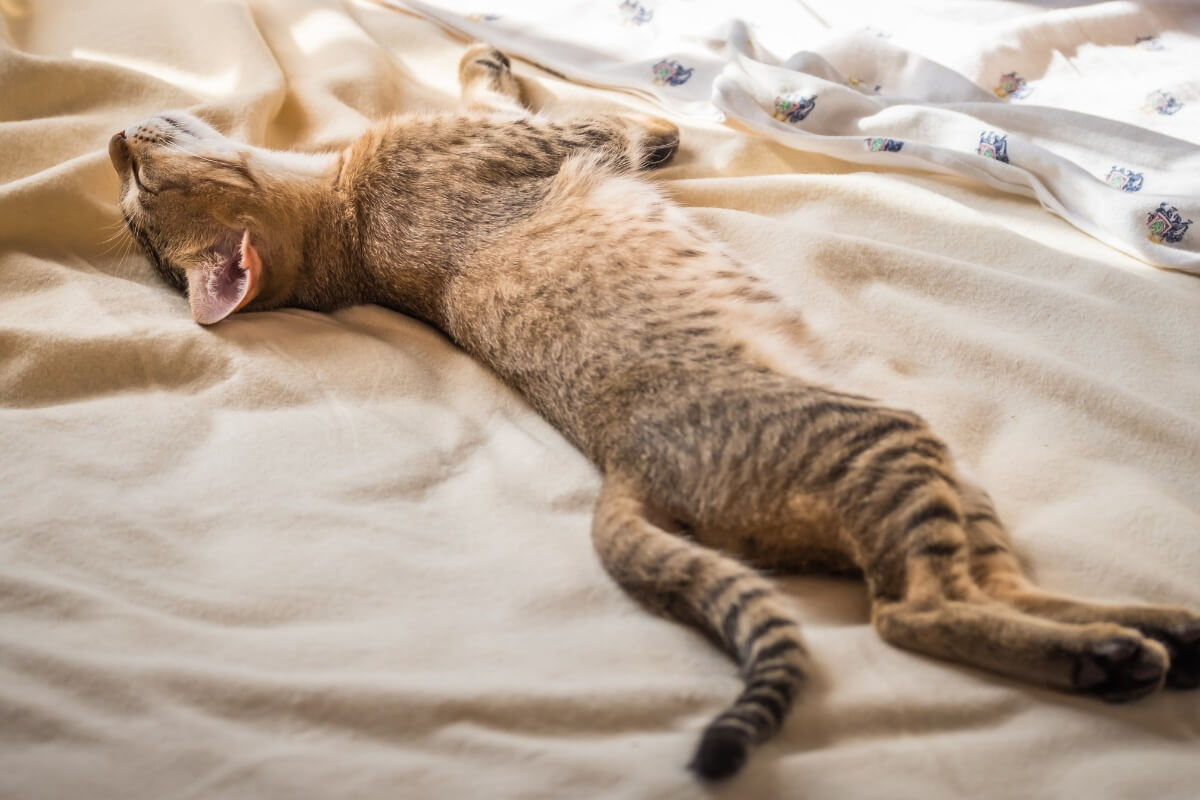4 Tips for Cat Skincare

Caring for a cat’s skin of cats is just as important as any other part of their body. Just like any other organ, the skin can suffer from diseases and needs specific nutrients to stay healthy, as it’s a tissue that is constantly exposed to various environmental stressors. Find out about cat skincare in today’s article.
Information and advice on cat dermatological care can be contradictory in internet searches. Therefore, here are a series of general tips to keep the epidermis of any breed of feline healthy.
Characteristics of a cat’s skin
The skin is the largest organ in the body and cats are no exception. The thickness of a cat’s skin is 0.4 millimeters, although it’s thicker in the area of the extremities and the back and thinner in the belly. Among its basic functions, you can find the following:
- Protecting the body from pathogens and external bodies.
- Working as a thermoregulator against changes in ambient temperature.
- Having a sensitive function that allows it to perceive the environment.
- Sending communicative signals: for example, when the cat bristles its fur, it sends a threatening message.

The skin as an indicator of general health
The condition of the skin and coat sends fairly reliable signals regarding the health of your cat. There are several reasons why cats’ skin can be damaged:
- Poor diet: The lack of essential nutrients for capillary health quickly manifests itself in the cat’s appearance.
- Excess weight: If the cat becomes too fat, it will be unable to reach certain parts of its body to groom itself.
- Old age: The loss of elasticity or the pains of old age can cause the cat to groom less than when it was young.
- Excessive bathing: When the cat is groomed, in addition to removing dirt, it distributes essential oils that are important to the health of its skin. Therefore, too frequent baths can eliminate this layer of fat that’s so necessary to protect the dermis.
- Illnesses: Pain or illness will stop the cat from grooming itself. On the other hand, conditions such as allergies or dermatitis also affect the appearance of a cat’s skin and hair.
4 tips for cat skincare
As we’ve already said, a cat’s skin is as important as the rest of its organs, and they cannot be neglected – especially in hairless breeds, such as the sphynx. If you want to know how to keep it healthy and the coat shiny, here are some tips.
1. Give them quality food
Giving it a balanced and specific feed is essential to keep your feline’s skin and fur in good condition. Every diet must contain healthy proteins and high levels of omega 3 and 6 fatty acids. Extra foods, such as sweets or wet cans, must be limited so as not to unbalance the diet.
As professional documents indicate, ideally 50% of the feline’s energy should come from protein sources. The remaining 30% will be natural fats – such as the fatty tissue present in meat and fish. Carbohydrates should account for less than 10% of caloric intake, but feed manufacturers sometimes use grains to cut costs.
For this reason, some owners choose to avoid food with cereals or grains in their composition.
2. Cat skincare at the vets
Regular deworming of your cat, especially if it goes outside, is necessary for good skincare. Periodic veterinary check-ups are useful both for dermatological issues and for other aspects of the cat’s health.
3. Bathe them only when necessary
In general, cats are very clean animals and do enough to keep themselves clean. However, there may be times when you need to bathe him.
When this occurs, it’s very important to minimize stress to the animal as much as possible. You can do it in a bathtub or large sink, with a mat that prevents it from slipping. You should use lukewarm water and make gentle movements.
Cleaning products have to be strictly made for felines. Only in this way will you guarantee that the skin or the pH of the cat’s epidermis isn’t altered. Depending on the pet’s habits, the frequency of bathing can vary between once a year and 2 times a month.
4. Brush it regularly
Dead hair that doesn’t shed prevents the skin from breathing properly, increasing the risk of diseases, such as dermatitis or the proliferation of mites. Use a brush suitable for your feline’s fur. If it has short hair, you won’t be able to use combs with very long bristles, for example, so that you don’t damage the fur in the process.

Taking care of your cat’s fur and skin will not only give it a healthy and shiny appearance, but will also avoid problems at all levels: allergies, parasites, seborrhea and many more.
You will even prevent your cat from having to vomit hairballs frequently. The appearance of your feline, far from mere aesthetics, will be the best indicator of how you should take care of its health.
Caring for a cat’s skin of cats is just as important as any other part of their body. Just like any other organ, the skin can suffer from diseases and needs specific nutrients to stay healthy, as it’s a tissue that is constantly exposed to various environmental stressors. Find out about cat skincare in today’s article.
Information and advice on cat dermatological care can be contradictory in internet searches. Therefore, here are a series of general tips to keep the epidermis of any breed of feline healthy.
Characteristics of a cat’s skin
The skin is the largest organ in the body and cats are no exception. The thickness of a cat’s skin is 0.4 millimeters, although it’s thicker in the area of the extremities and the back and thinner in the belly. Among its basic functions, you can find the following:
- Protecting the body from pathogens and external bodies.
- Working as a thermoregulator against changes in ambient temperature.
- Having a sensitive function that allows it to perceive the environment.
- Sending communicative signals: for example, when the cat bristles its fur, it sends a threatening message.

The skin as an indicator of general health
The condition of the skin and coat sends fairly reliable signals regarding the health of your cat. There are several reasons why cats’ skin can be damaged:
- Poor diet: The lack of essential nutrients for capillary health quickly manifests itself in the cat’s appearance.
- Excess weight: If the cat becomes too fat, it will be unable to reach certain parts of its body to groom itself.
- Old age: The loss of elasticity or the pains of old age can cause the cat to groom less than when it was young.
- Excessive bathing: When the cat is groomed, in addition to removing dirt, it distributes essential oils that are important to the health of its skin. Therefore, too frequent baths can eliminate this layer of fat that’s so necessary to protect the dermis.
- Illnesses: Pain or illness will stop the cat from grooming itself. On the other hand, conditions such as allergies or dermatitis also affect the appearance of a cat’s skin and hair.
4 tips for cat skincare
As we’ve already said, a cat’s skin is as important as the rest of its organs, and they cannot be neglected – especially in hairless breeds, such as the sphynx. If you want to know how to keep it healthy and the coat shiny, here are some tips.
1. Give them quality food
Giving it a balanced and specific feed is essential to keep your feline’s skin and fur in good condition. Every diet must contain healthy proteins and high levels of omega 3 and 6 fatty acids. Extra foods, such as sweets or wet cans, must be limited so as not to unbalance the diet.
As professional documents indicate, ideally 50% of the feline’s energy should come from protein sources. The remaining 30% will be natural fats – such as the fatty tissue present in meat and fish. Carbohydrates should account for less than 10% of caloric intake, but feed manufacturers sometimes use grains to cut costs.
For this reason, some owners choose to avoid food with cereals or grains in their composition.
2. Cat skincare at the vets
Regular deworming of your cat, especially if it goes outside, is necessary for good skincare. Periodic veterinary check-ups are useful both for dermatological issues and for other aspects of the cat’s health.
3. Bathe them only when necessary
In general, cats are very clean animals and do enough to keep themselves clean. However, there may be times when you need to bathe him.
When this occurs, it’s very important to minimize stress to the animal as much as possible. You can do it in a bathtub or large sink, with a mat that prevents it from slipping. You should use lukewarm water and make gentle movements.
Cleaning products have to be strictly made for felines. Only in this way will you guarantee that the skin or the pH of the cat’s epidermis isn’t altered. Depending on the pet’s habits, the frequency of bathing can vary between once a year and 2 times a month.
4. Brush it regularly
Dead hair that doesn’t shed prevents the skin from breathing properly, increasing the risk of diseases, such as dermatitis or the proliferation of mites. Use a brush suitable for your feline’s fur. If it has short hair, you won’t be able to use combs with very long bristles, for example, so that you don’t damage the fur in the process.

Taking care of your cat’s fur and skin will not only give it a healthy and shiny appearance, but will also avoid problems at all levels: allergies, parasites, seborrhea and many more.
You will even prevent your cat from having to vomit hairballs frequently. The appearance of your feline, far from mere aesthetics, will be the best indicator of how you should take care of its health.
All cited sources were thoroughly reviewed by our team to ensure their quality, reliability, currency, and validity. The bibliography of this article was considered reliable and of academic or scientific accuracy.
- Overweight Dogs and Cats: Pet Obesity Risks. (2021). Best Friends Animal Society. https://resources.bestfriends.org/article/overweight-dogs-and-cats-pet-obesity-risks
- Problemas de piel en los gatos – Veterinarios de Alicante. (2018). ICOVAL. https://www.icoval.org/detallenews.php?art=133
- How, K. L., Hazewinkel, H. A. W., & Mol, J. A. (1994). Dietary vitamin D dependence of cat and dog due to inadequate cutaneous synthesis of vitamin D. General and comparative endocrinology, 96(1), 12-18.
- Paterson, S. (2009). Manual of skin diseases of the dog and cat. John Wiley & Sons.
- Coat and skin appearance in a healthy cat, VCA hospitals. Recogido a 7 de junio en https://vcahospitals.com/know-your-pet/coat-and-skin-appearance-in-the-healthy-cat
- Hill, P., Lo, A., Eden, C. A. N., Huntley, S., Morey, V., Ramsey, S., … & Williams, V. (2006). Survey of the prevalence, diagnosis and treatment of dermatological conditions in small animals in general practice. Veterinary record, 158(16), 533-539.
This text is provided for informational purposes only and does not replace consultation with a professional. If in doubt, consult your specialist.








